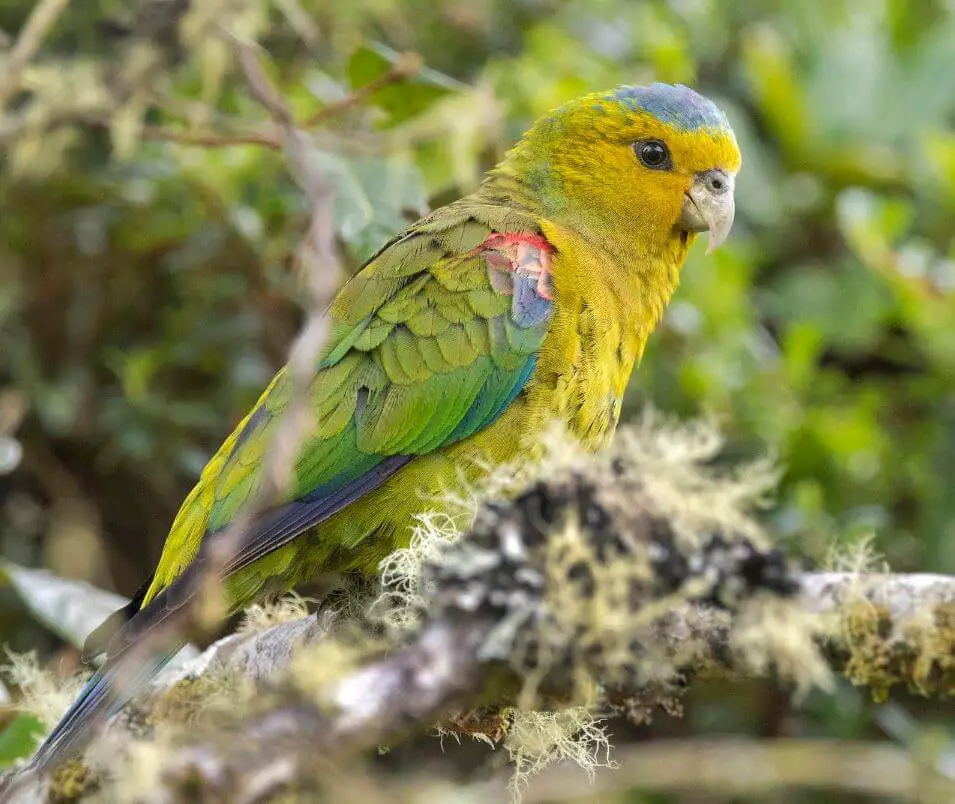
The Indigo-winged Parrot or Fuertes’s Parrot is one of the most threatened Psittacidae in the world, it is considered Critically Endangered by BirdLife International.
Indigo-winged Parrot is also a highly attractive species, although deforestation has been the cause of this parrot’s ‘downfall’, not illegal trade.
A chunky, mainly green parrot, the principal features are the orange-red frontal bar, the yellow forecrown and face, blue rear crown and nape, red shoulder and carpal, and dark bluish primaries.
The breast is yellow-olive, there is a variable, red central belly patch, and the tail is red with a violet tip.
Indigo-winged Parrot is confined to the west slope of the Central Andes in Colombia, where it inhabits temperate cloud forest above 2600 m, and the species is now the subject of a considerable conservation effort.
The Indigo-winged Parrot’s scientific name honors one of the ‘greats’ of American bird art, Louis Agassiz Fuertes.
Identification
Indigo-winged Parrot 23–24 cm; 124 g. Quite small and stocky parrot, with a rather short, slightly tapered tail. Narrow red frontal band, while forecrown and area around eyes are olive-yellow,blue crown, hindneck and neck-sides green, mantle green with paler fringes to feathers, and rest of upperparts green;
lesser coverts, wing-bend and the leading edge of wing crimson-red, median and greater coverts dark violet-blue, with almost black primary-coverts, primaries black-edged purplish-blue, secondaries mainly blue with green edges to outer webs;
underwing greenish-blue except for crimson lesser coverts; throat and breast green-tinged golden-olive, belly, thighs and under tail-coverts yellowish-green, with variable amounts of dull red on belly; upper tail blue with red bases to inner webs of rectrices, under tail duller.
Bare parts: bill horn, darker at base of mandible, eyes yellowish, and legs and feet dark grey. Sexes alike.

Indigo-winged Parrot
Immature undescribed. Very like H. amazonian, but red on face confined to the area over the bill and no yellow streaking; forehead and upper cheeks dull yellow; mid- to hind crown blue; belly with a dull red patch.
Systematics History
Forms a species group with H. amazonian and H. perhaps, and all three have commonly been considered conspecific. Monotypic.

Subspecies
Monotypic.
Distribution
W slope of C Andes of Colombia (Quindío, Risaralda).
Habitat
Wet, epiphyte-rich temperate cloud forest including oaks Quercus at 2610–3490 m, the majority of records being at 2900–3150 m.
Indigo-winged Parrot in Colombia
SOURCE: Loro Parque
Movement
Unknown, but altitudinal displacements probably occur.
Diet and Foraging
All data gathered recently: preferentially selects fruits of Antidaphne (Eremolepidaceae). Feeds in flocks of 7–15 individuals.
Sounds and Vocal Behavior
Flight call is a rather nasal, grating “krraa”, which is rather Aratinga-like. When perched, utters similar call notes.
Breeding
Studies since 2003 have gathered extensive information on the species’ breeding ecology, with the nesting period being from Jan to May.
Nests in natural or man-made cavities (see below) on the following trees: Weinmannia, Ruagea hirsute, Ocotea heterochromia, Myrciantes rophaloides, and Podocarpus oleifolius.
Clutch 3–4 white eggs, size 35·6 mm × 28·5 mm, with incubation solely by the female for 24·5–26·5 days, although post-hatching care is biparental;
fledging period 55–64·5 days, weighing c. 16·5 g on hatching and a maximum weight of 125–148 g just before fledging.
In Dec 2003, 120 nest boxes (25 cm × 25 cm × 100 cm, with a 10 cm × 10 cm entrance hole) were erected for the species at Reserva Municipal El Mirador and nearby areas, and during the following season the species nested in eight of them (laying 29 eggs of which 21 hatched and all of the chicks survived to fledge), whereas in 2005 a total of 12 was found:
11 in nestboxes and one in a natural cavity (11·5 m above ground), with four of the nests (including that in the natural cavity) in sites, also used the previous season; of the 39 eggs laid in nestboxes, 32 (82%) hatched successfully, with the remaining seven eggs (from five clutches) being infertile, with 25 nestlings (i.e. 78% of those that hatched) fledging successfully.
All three chicks in one brood were predated by a small mammal, two chicks in a four-chick brood starved following the loss of one of the adults, and single chicks deserted the nest and were lost to unknown causes; overall, ten (91%) nests in boxes successfully fledged one or more chicks.
Conservation Status

Indigo-winged Parrot
CRITICALLY ENDANGERED. CITES II. Restricted-range species: present in Northern Central Andes EBA.
Overall population estimated at 160#R–250 birds, and certainly fewer than 250 mature individuals#R; considered to be one of South America’s rarest Indigo-winged Parrot.
Extremely rare, and only known from Alto Quindío Acaime and Cañón del Quindío Natural Reserves, where the largest group seen was 25, although a new locality was discovered in Risaralda in Mar 2015.
No records between 1992 and 2002, when the first confirmed sighting was made in C Andes, near Los Nevados National Park, with 14 birds being found in a small area of the forest:
the population has increased to 160 individuals due to conservation efforts, which have resulted in 87% hatching success and 95% fledging success amongst breeding birds in the Central Cordillera (see Breeding).
An area of 631 ha of core habitat is being managed as Loro Coroniazul Bird Reserve, while another recently protected area,
the Giles-Fuertesi Bird Reserve in Cajamarca, comprises nearly 300 ha at 3200–3700 m, including areas of cloud forest, and has become a center for research focused on the species.
Nest-boxes have been very successful at allowing high breeding success, and 20 were installed in the new Giles-Fuertesi Bird Reserve in Jan 2010, but are generally being used by Leptosittaca brickie to an increasing extent, thus additional boxes are being constructed to reduce competition.
A Species Conservation Plan was established in early 2008, and since 2005 the ProAves ‘Parrot Bus’ has been raising awareness through environmental education programs in the C Andes.
Extensive deforestation coupled with competition from H. amazonian Velez may have caused it to have become so strictly confined.
It has not been traded and there are no individuals known in captivity. Considered Critically Endangered at the national level in Colombia.
SOURCE: American Bird Conservancy




















